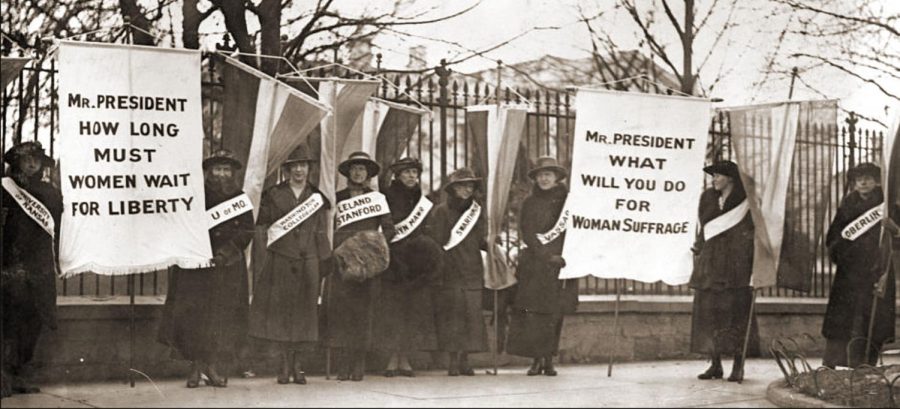Celebrating 100 years of Women voters
“College day in the picket line” from the Library of Congress.
March 13, 2020
It has been 100 years since the 19th Amendment granted women the power to vote. Although women were granted the right to vote in 1920, the movement began about 80 years prior.
In 1848, the first woman’s rights convention was held. While nothing was accomplished legally at the Seneca Falls Convention, the gathering of women launched the women’s suffrage movement.
In 1869, the first national organizations were formed for women’s suffrage. Susan B. Anthony and Elizabeth Cady Stone established the National Woman Suffrage Association, and Lucy Stone established the American Woman Suffrage Association.
Shortly after the two organizations were established, the Woman’s Christian Temperance Union (WCTU) was established in 1873. Being the largest group of organized women at the time, the WCTU pursued women’s suffrage as well, giving a large boost in popularity to the movement.
In efforts to see if the U.S. Supreme Court would rule that women had the constitutional right to vote, many suffragists made attempts to vote and then filed lawsuits when they were turned away.
While they didn’t succeed in voting, Susan B. Anthony did. She was arrested for it, and in a publicized trial she was found guilty. This gave the movement fresh momentum for the next few decades.
In 1890, after 21 years of independent operation, the NWSA and the AWSA joined forces to create the National American Woman Suffrage Association, or NAWSA for short.
While Lucy Stone would pass in 1893 and Susan B. Anthony would pass in 1906, they did plenty of work for women’s suffrage.
Between 1870 and 1910, the movement conducted 480 campaigns in 33 states. Within those 33 states, 17 added the instance to their ballots. The efforts led to women’s suffrage in two states, Colorado and Idaho.
However, this was not enough for the suffrage movement. After pioneers Anthony and Stone passed, other movements began to unfold.
In 1916, suffragist Alice Paul formed the National Women’s Party (NWP). The NWP was a militant group that focused on passing a national suffrage amendment.
A group of the women from the NWP, known as the Silent Sentinels were arrested for picketing the White House in 1917. Some women went on hunger strike and went through forced feeding after being sent to prison.
Eventually in 1919, new NAWSA president Carrie Chapman Catt led 2-million NAWSA members.
After a series of hard-fought votes in the U.S. Congress and state legislatures, the Nineteenth Amendment was ratified and became part of the U.S. Constitution on Aug. 18, 1920.
After decades of fighting, martyrdom and hardship, women in the United States finally achieved suffrage.
LMC student Jennifer Escajeda shared her thoughts on how the movement affected her. “I got to vote, I was happy to vote. I know it’s a privilege not many people had back then. I think it’s important. If we’re all able to vote we should vote,” said Escajeda.


